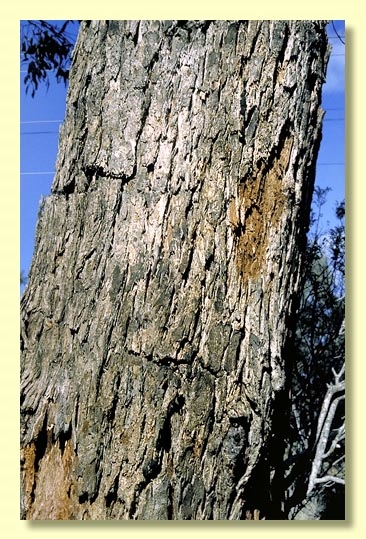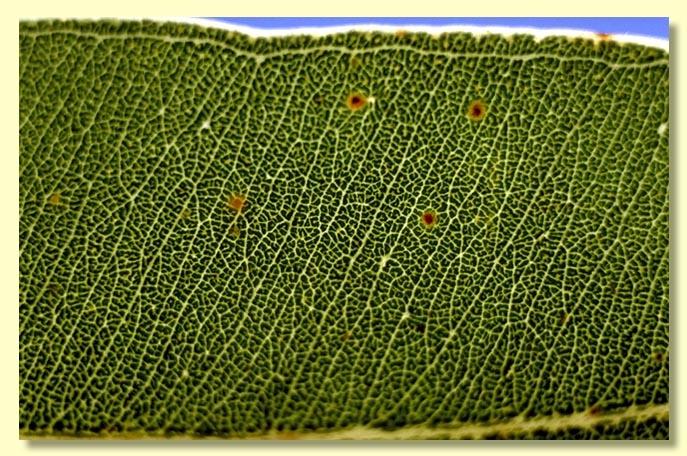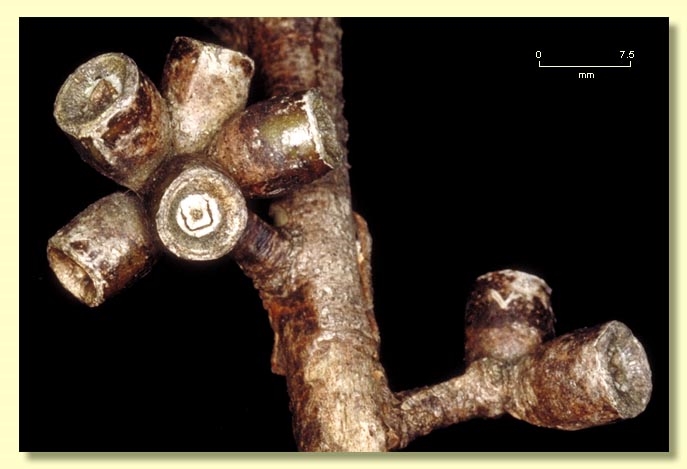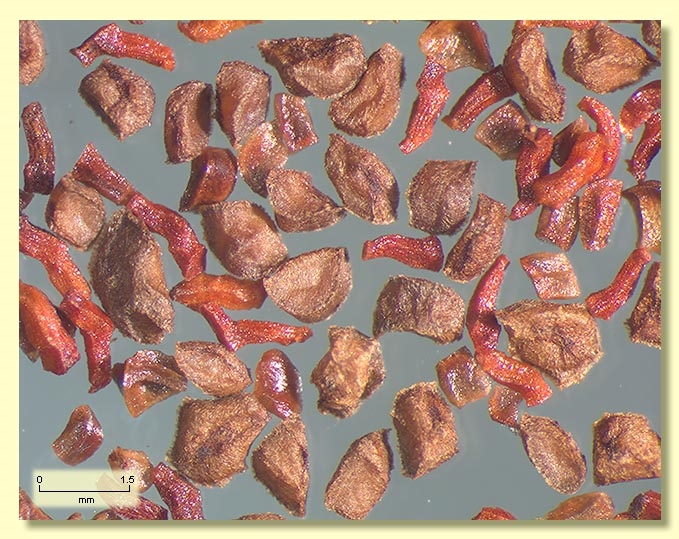Euclid - Online edition
Eucalyptus botryoides
Eucalyptus | Symphyomyrtus | Latoangulatae | Annulares
E. saligna var. botryoides (Sm.) Maiden, Proc. Linn. Soc. of New South Wales 30 (Apr. 1906) 502. E. saligna Sm. subsp. botryoides (Sm.) Passioura & Ash, Aust. Syst. Bot. 6: 181 (1993). T: Port Jackson, NSW, 1794, J.White s.n.; holo: LINN; iso: BM,G.
E. platypodos Cav., Icon. 4: 23, t. 341 (1797). T: Port Jackson, NSW, 1794, J.White s.n. ; holo: LINN.
E. botryoides var. platycarpa Blakely, Key Eucalypts 97 (1934). T: Newport, NSW, July 1905, J.H.Maiden & R.H.Cambage s.n.; holo: NSW.
Bark rough on trunk and larger limbs in thick, elongated, fibrous, grey or brown strips; smooth bark predominantly white, cream, or pale brown.
Juvenile growth (coppice or field seedlings to 50 cm): stem rounded or square in cross-section; juvenile leaves petiolate, discolorous, opposite for a few pairs then alternate, ovate to lanceolate, 6.5–11.5 cm long, 2.4–5.8 cm wide, green.
Adult leaves alternate, petiole 1.5–3.5 cm long; blade broadly lanceolate to falcate, 10–22 cm long, 2–7 cm wide, base tapering to petiole, discolorous, glossy, darker green above, paler below, strongly penniveined, densely to very densely reticulate, intramarginal vein parallel to and just within margin or well removed from it, oil glands intersectional or obscure.
Inflorescence axillary unbranched, peduncle broadly flattened, 0.7–1.5 cm long, buds 7, 9 or 11 per umbel, usually sessile, rarely pedicellate (pedicels 0–0.3 cm long). Mature buds oblong to ovoid (0.7–1.4 cm long, 0.4–0.6 cm wide), green to yellow, smooth, hypanthium usually slightly angled, scar present, operculum conical to rounded, stamens inflexed or irregularly flexed, anthers cuboid to oblong, versatile, dorsifixed, dehiscing by longitudinal slits (non-confluent), style long, stigma blunt or tapered, locules 3 or 4, the placentae each with 4 vertical ovule rows. Flowers white.
Fruit sessile or pedicellate (pedicels 0–0.3 cm long), cylindrical or barrel-shaped, 0.6–1.3 cm long, 0.5–0.9 cm wide, often angled longitudinally, disc descending, valves 3 or 4, near rim level or enclosed.
Seeds brown, 0.8–2.2 mm long, pyramidal or cuboid or somewhat flattened, edges often toothed, dorsal surface smooth or pitted, hilum ventral or terminal.
Cultivated seedlings (measured at ca node 10): cotyledons bilobed; stems square in cross-section; leaves always petiolate, opposite for 5 or 6 nodes then alternate, ovate-lanceolate, 3.5–11 cm long, 1.3–5.5 cm wide, discolorous, dark green above.
Flowering has been recorded in December, January and February.
Produces timber suitable for structural purposes and is a useful honey species. Also grown as an ornamental plant, particularly in coastal areas close to the sea.
In Western Australia Eucalyptus botryoides has escaped from plantings and become naturalised (Hussey et al., 1997), e.g. near Hamel on the sandplain south of Perth. In Victoria Carr et al. (1992) regard this species as an environmental weed posing a serious risk to heath, dry sclerophyll forest and woodland, and lowland grassland, noting it as already widespread but occurring in small populations.
A small to medium-sized red mahogany tree of south coastal New South Wales and eastern Victoria, from coastal dunes to low subcoastal hills. It has red-brown fibrous bark held in elongated thick strips and strongly discolorous leaves darker green on the upper side, and elongated buds and fruit that vary from being sessile to shortly pedicellate.
Eucalyptus botryoides belongs in Eucalyptus subgenus Symphyomyrtus section Latoangulatae because cotyledons are bilobed, leaves are discolorous and have side-veins at a wide angle to the midrib, buds have two opercula and fruit have exserted valves. Within this section, E. botryoides is one of seven species forming series Annulares (the red mahoganies), as it has ovules in 6 or 8 rows, seeds cuboid to pyramidal and bark rough over the trunk. The other six species are E. pellita from coastal north Queensland and New Guinea, E. urophylla from Timor and other islands to the north-west of Australia (and not included in EUCLID), E. notabilis scattered in coastal and subcoastal New South Wales and south-eastern Queensland, E. scias endemic to New South Wales from the coastal and subcoastal ranges, principally from Batemans Bay north to Cessnock with a disjunct occurence east of Tenterfield (subsp. apoda), E. resinifera (with two subspecies) and E. robusta both widespread in coastal New South Wales and Queensland.
Within this group it is closest to E. robusta and is distinguished by having smaller buds and fruit, but the fruit lack the joined valves of E. robusta. The other red mahoganies are distinguished by having cup-shaped to funnel-shaped fruit (not cylindrical or barrel-shaped like E. botryoides).
In the northern end of its distribution, E. botryoides intergrades with E. saligna, which is mostly smooth-barked, and some populations of 'half-barks' cannot be ascribed to either species, e.g. those in Kangaroo Valley.















